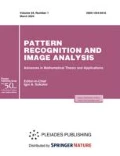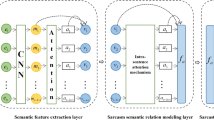Abstract
Sentiment analysis and sarcasm detection are specialized areas in the field of information retrieval and natural language processing. Sentiment classification is closely correlated with sarcasm detection, where people usually adopt sarcasm to highlight their negative feeling. This paper proposes a novel multi-task deep neural networks for joint sarcasm detection and sentiment analysis (MT_SS). MT_SS train both tasks jointly using bidirectional gated recurrent unit with attention network module to obtain task-specific local feature representation while using convolutional neural networks to obtain global feature representation. The experiments on two datasets show that our proposed model outperforms the state-of-the-art approaches.

Similar content being viewed by others
REFERENCES
A. Khattri, A. Joshi, P. Bhattacharyya, et al., “Your sentiment precedes you: Using an author’s historical tweets to predict sarcasm,” in Proceedings of the 6th Workshop on Computational Approaches to Subjectivity, Sentiment and Social Media Analysis (2015), pp. 25–30.
M. Abulaish and A. Kamal, “Self-deprecating sarcasm detection: An amalgamation of rule-based and machine learning approach,” in IEEE/WIC/ACM International Conference on Web Intelligence (2018), pp. 574–579.
A. Dubey, L. Kumar, A. Somani, et al., “‘When numbers matter!’: Detecting sarcasm in numerical portions of text,” in Proceedings of the Tenth Workshop on Computational Approaches to Subjectivity, Sentiment, and Social Media Analysis (2019), pp. 72–80.
Karthik Sundararajan and Anandhakumar Palanisamy, “Multi-rule based ensemble feature selection model for sarcasm type detection in Twitter,” Comput. Intell. Neurosci. 2020, 2860479 (2020).
A. Mishra, K. Dey, and P. Bhattacharyya, “Learning cognitive features from gaze data for sentiment and sarcasm classification using convolutional neural network,” in Proceedings of Annual Meeting of the Association for Computational Linguistics (2017), pp. 377–387.
Y. Ren, D. Ji, and H. Ren, “Context-augmented convolutional neural networks for Twitter sarcasm detection,” Neurocomputing 308, 1–7 (2018).
L. H. Son, A. Kumar, S. R. Sangwan, et al., “Sarcasm detection using soft attention-based bidirectional long short-term memory model with convolution network,” IEEE Access 7, 23319–23328 (2019).
M. Lan, J. Wang, Y. Wu, Z.-Y. Niu, and H. Wang, “Multi-task attention-based neural networks for implicit discourse relationship representation and identification,” in Proceedings of Conference on Empirical Methods in Natural Language Processing (2017), pp. 1299–1308.
I. Augenstein and A. Søgaard, “Multi-task learning of keyphrase boundary classification,” in Proceedings of the Annual Meeting of the Association for Computational Linguistics (2017), pp. 341–346.
Siwei Lai, Liheng Xu, Kang Liu, and Jun Zhao, “Recurrent convolutional neural networks for text classification,” in Proceedings of the Twenty-Ninth AAAI Conference on Artificial Intelligence (2015), pp. 2267–2273.
K. Cho, B. Van Merrienboer, C. Gulcehre, et al., “Learning phrase representations using RNN encoder-decoder for statistical machine translation,” in Proceedings of the 2014 Conference on Empirical Methods in Natural Language Processing (EMNLP) (2014), pp. 1724–1734.
R. Socher, D. Chen, C. D. Manning, and A. Ng, “Reasoning with neural tensor networks for knowledge base completion,” in NIPS’13: Proceedings of the 26th International Conference on Neural Information Processing Systems (2013), Vol. 1, pp. 926–934.
A. Mishra, D. Kanojia, and P. Bhattacharyya, “Predicting readers’ sarcasm understandability by modeling gaze behavior,” Adv. Visual Comput. 30, 3747–3753 (2016).
Rishabh Misra and Prahal Arora, Sarcasm Detection Using Hybrid Neural Network (2019). https://doi.org/10.13140/RG.2.2.32427.39204
X. Liu, J. Gao, X. He, L. Deng, K. Duh, and Y. Wang, “Representation learning using multi-task deep neural networks for semantic classification and information retrieval,” in Proceedings of the 2015 Conference of the North American Chapter of the Association for Computational Linguistics: Human Language Technologies (2015), pp. 912–921.
P. Liu, X. Qiu, and X. Huang, “Recurrent neural network for text classification with multi-task learning,” in International Joint Conference on Artificial Intelligence (2016), pp. 2873–2879.
Funding
This work is supported by the National Natural Science Foundation of China nos. 61303131, 61672272; Natural Science Foundation Project of Fujian no. 2018J01547; Scientific and Technological Project of Zhanjiang nos. 2020B01272, 2020B01252.
Author information
Authors and Affiliations
Corresponding author
Ethics declarations
The authors declare that they have no conflicts of interest. This article does not contain any studies involving animals performed by any of the authors. Informed consent was obtained from all individual participants involved in the study.
Additional information

Chunyan Yin. She obtained the B.S. degree from Harbin Normal University in 2002. Main research area covers database theory, machine learning, data mining, and granular computing.

Yongheng Chen. He received the Ph.D. degree from Jilin University in 2012. His current main research interests include data mining, web intelligence and ontology engineering, and information integration. He is a member of System Software Committee of China’s Computer Federation.

Wanli Zuo. He is a professor and doctoral supervisor at Department of Computer Science and technology, Jilin University and China’s Computer Federation senior member. Main research area covers database theory, machine learning, data mining and web mining, web search engines, web intelligence.
Rights and permissions
About this article
Cite this article
Chunyan Yin, Chen, Y. & Zuo, W. Multi-Task Deep Neural Networks for Joint Sarcasm Detection and Sentiment Analysis. Pattern Recognit. Image Anal. 31, 103–108 (2021). https://doi.org/10.1134/S105466182101017X
Received:
Revised:
Accepted:
Published:
Issue Date:
DOI: https://doi.org/10.1134/S105466182101017X




